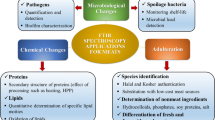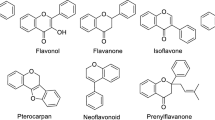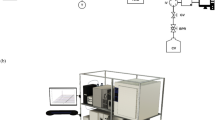Abstract
Here, a comprehensive approach, based on chromatographic profiles and chemometric methods, was developed for the simultaneous qualitative and quantitative determinations of goji berry. High-performance liquid chromatography with diode-array detection (HPLC-DAD) was employed to acquire the fingerprints of 67 water extracts of goji berries of different varieties and growing years. The results indicated that the correlation coefficients among the samples of the same varieties and growing years were ˃ 0.900, although they varied from 0.726 to 0.986 among samples of different varieties and growing years. Based on these data, the chemometric analysis was applied. Further, principal component analysis (PCA), hierarchical clustering analysis (HCA), and orthogonal partial least squares discriminant analysis (OPLS-DA) were applied for the discrimination of the varieties and the growing years. Moreover, nine marker compounds were obtained as potential references for goji berries of different growing years and 10 other marker components contributed significantly to the varieties differentiation. Precisely, the goji berries of Ningqi No. 7 (N7) and Ningqi No. 9 (N9) were of higher contents than the other three varieties (Ningqi No. 1 (N1), Ningqi No. 5 (N5), and Zhongke Luchuan (ZKLC)), indicating that N7 and N9 were of higher qualities than the others. Conclusively, the chromatographic fingerprint, combined with chemometric methods, could be employed to differentiate the raw materials of different varieties and growing years. Additionally, it could be employed as a rapid and reliable tool for the quality control (QC) of goji berries.








Similar content being viewed by others
References
Bajoub A, Medina-Rodriguez S, Gomez-Romero M, Ajal E, Bagur-Gonzalez MG, Fernandez-Gutierrez A, Carrasco-Pancorbo A (2017) Assessing the varietal origin of extra-virgin olive oil using liquid chromatography fingerprints of phenolic compound, data fusion and chemometrics. Food Chem 215:245–255. https://doi.org/10.1016/j.foodchem.2016.07.140
Benchennouf A, Grigorakis S, Loupassaki S, Kokkalou E (2017) Phytochemical analysis and antioxidant activity of Lycium barbarum (Goji) cultivated in Greece. Pharm Biol 55:596–602. https://doi.org/10.1080/13880209.2016.1265987
Bertoldi D, Cossignani L, Blasi F, Perini M, Barbero A, Pianezze S, Montesano D (2019) Characterisation and geographical traceability of Italian goji berries. Food Chem 275:585–593. https://doi.org/10.1016/j.foodchem.2018.09.098
Bondia-Pons I, Savolainen O, Torronen R, Martinez JA, Poutanen K, Hanhineva K (2014) Metabolic profiling of goji berry extracts for discrimination of geographical origin by non-targeted liquid chromatography coupled to quadrupole time-of-flight mass spectrometry. Food Res Int 63:132–138. https://doi.org/10.1016/j.foodres.2014.01.067
Bylesjö M, Rantalainen M, Cloarec O, Nicholson JK, Holmes E, Trygg J (2006) OPLS discriminant analysis: combining the strengths of PLS-DA and SIMCA classification. J Chemom 20:341–351. https://doi.org/10.1002/cem.1006
Capecchi G, Goti E, Nicolai E, Bergonzi MC, Monnanni R, Bilia AR (2015) Goji Berry: Quality assessment and crop adaptation of plants cultivated in Tuscany (Italy) by combination of carotenoid and DNA analyses. Nat Prod Commun 10:1035–1036
Chen X, Wu QX, Chen ZSZ, Li TT, Zhang ZK, Gao HJ, Yun Z, Jiang YM (2019) Changes in pericarp metabolite profiling of four litchi cultivars during browning. Food Res Int 120:339–351. https://doi.org/10.1016/j.foodres.2019.02.046
ChengXM, Zhao T, Yang T, Wang CH, Bligh SWA , Wang ZT (2010) HPLC fingerprints combinedwith principal component analysis, hierarchical cluster analysis and linear discriminantanalysis for the classification and differentiation of Peganum sp. indigenous to China. Phytochem Anal 21:279–289. https://doi.org/10.1002/pca.1198
Chinese Pharmacopoeia Commission (2015) Pharmacopoeia of the People’s Republic of China: VolI. China Medical Science Press, Beijing, p 249
Colak AM, Okatan V, Polat M, Guclu SF (2019) Different harvest times affect market quality of Lycium barbarum L. berries. Turk J Agric For 43:326–333. https://doi.org/10.3906/tar-1808-17
Gao FY, Xu ZH, Wang WZ, Lu GC, Heyden YV, Zhou TT, Fan GR (2016) A comprehensive strategy using chromatographic profiles combined with chemometric methods: application to quality control of Polygonum cuspidat-um Sieb. et Zucc. J Chromatogr A 1466:67–75. https://doi.org/10.1016/j.chroma.2016.08.050
Gonzalez MD, Lanzelotti PL, Luis CM (2017) Characterization of the polyphenolic fingerprint of origanum × majoricum cambess. from argentina by high-performance liquid chromatography and multivariate analysis. Food Anal Methods 10:3275–3284. https://doi.org/10.1007/s12161-017-0894-2
Hori K, Kiriyama T, Tsumura K (2016) A liquid chromatography time-of-flight mass spectrometry-based metabolomics approach for the discrimination of cocoa beans from different growing regions. Food Anal Methods 9:738–743. https://doi.org/10.1007/s12161-015-0245-0
Hrbek V, Krtkova V, Rubert J, Chmelarova H, Demnerova K, Ovesna J, Hajslova J (2017) Metabolomic strategies based on high-resolution mass spectrometry as a tool for recognition of GMO (MON 89788 variety) and non-GMO soybean: a critical assessment of two complementary methods. Food Anal Methods 10:3723–3737. https://doi.org/10.1007/s12161-017-0929-8
Jarouche M, Suresh H, Hennell J, Sullivan S, Lee S, Singh S, Power D, Xu C, Khoo C (2019) The quality assessment of commercial Lycium berries using LC-ESI-MS/MS and chemometrics. Plants-Basel 8:604. https://doi.org/10.3390/plants8120604
Jeszka-Skowron M, Oszust K, Zgola-Grzeskowiak A, Frac M (2018) Quality assessment of goji fruits, cranberries, and raisins using selected markers. Eur Food Res Technol 244:2159–2168. https://doi.org/10.1007/s00217-018-3125-1
Jin Q, Jiao CY, Sun SW, Song C, Cai YP, Lin Y, Fan HH, Zhu YF (2016) Metabolic analysis of medicinal dendrobium officinale and dendrobium huoshanense during different growth years. PLoS One 11:e0146607. https://doi.org/10.1371/journal.pone.0146607
Kim JH, Seo CS, Kim SS, Shin HK (2015) Quality assessment of Ojeok-San, a traditional herbal formula, using high-performance liquid chromatography combined with chemometric analysis. J Anal Methods Chem:607252. https://doi.org/10.1155/2015/607252
Kosinska-Cagnazzo A, Weber B, Chablais R, Vouillamoz JF, Molnar B, Crovadore J, Lefort F, Andlauer W (2017) Bioactive compound profile and antioxidant activity of fruits from six goji cultivars cultivated in Switzerland. J Berry Res 7:43–59. https://doi.org/10.3233/JBR-160144
Li XT, Li RY, Xiang HE, Zhao ZL, Liu XH (2012) Study on quality evaluation of Lycium chinense from different areas by HPLC fingerprint and cluster analysis. Mod Food. Sci Technol 28:1251–1253. https://doi.org/10.13982/j.mfst.1673-9078.2012.09.002
Li Q, Yu XZ, Xu LR, Gao JM (2017) Novel method for the producing area identification of Zhongning Goji berries by electronic nose. Food Chem 221:1113–1119. https://doi.org/10.1016/j.foodchem.2016.11.049
Lima DC, Dos Santos AMP, Araujo RGO, Scarminio IS, Bruns RE, Ferreira SLC (2010) Principal component analysis and hierarchical cluster analysis for homogeneity evaluation during the preparation of a wheat flour laboratory reference material for inorganic analysis. Microchem J 95:222–226. https://doi.org/10.1016/j.microc.2009.12.003
Liu JD, Chen N, Yang J, Yang B, Ouyang Z, Wu CX, Yuan Y, Wang WH, Chen M (2018) An integrated approach combining HPLC, GC/MS, NIRS, and chemometrics for the geographical discrimination and commercial categorization of saffron. Food Chem 253:284–292. https://doi.org/10.1016/j.foodchem.2018.01.140
Liu XX, Pei D, Liu JF, Gong Y, Wang MH, Di DL, Guo M (2019) The study of HPLC fingerprint and chemical pattern recognition of Lycii fructus. Nat Prod Res Dev 31:1675–1681. https://doi.org/10.16333/j.1001-6880.2019.10.002
Lu JW, Tan YP, Wang G (2013) Discriminative multimanifold analysis for face recognition from a single training sample per person. IEEE Trans Pattern Anal Mach Intell 35:39–51. https://doi.org/10.1109/TPAMI.2012.70
Lu WY, Jiang QQ, Shi HM, Niu YG, Gao BY, Yu LL (2014) Partial least-squares-discriminant analysis differentiating Chinese wolfberries by UPLC−MS and flow injection mass spectrometric (FIMS) fingerprints. J Agric Food Chem 62:9073–9080. https://doi.org/10.1021/jf502156n
Ma HL, Qin MJ, Qi LW, Wu G, Shu P (2007) Improved quality evaluation of Radix Salvia miltiorrhiza through simultaneous quantification of seven major active components by high performance liquid chromatography and principal component analysis. Biomed Chromatogr 21:931–939. https://doi.org/10.1002/bmc.836
Mao Q, Bai M, Xu JD, Kong M, Zhu LY, Zhu H, Wang Q, Li SL (2014) Discrimination of leaves of Panax ginseng and P. Quinquefolius by ultra high performance liquid chromatography quadrupole/time-of-flight mass spectrometry based metabolomics approach. J Pharm Biomed Anal 97:129–140. https://doi.org/10.1016/j.jpba.2014.04.032
Mocan A, Cairone F, Locatelli M, Cacciagrano F, Carradori S, Vodnar DC, Crisan G, Simonetti G, Cesa S (2019) Polyphenols from Lycium barbarum (Goji) fruit european cultivars at different maturation steps: extraction, HPLC-DAD analyses, and biological evaluation. Antioxid 8:562. https://doi.org/10.3390/antiox8110562
Nikles S, Monschein M, Zou HQ, Liu Y, He XJ, Fan DP, Lu AP, Kate Y, Giorgis I, Rudolf B (2017) Metabolic profiling of the traditional Chinese medicine formulation Yu Ping Feng San for the identification of constituents relevant for effects on expression of TNF-α, IFN-γ, IL-1β and IL-4 in U937 cells. J Pharm Biomed Anal 145:219–229. https://doi.org/10.1016/j.jpba.2017.03.049
Peng Q, Xu X, Xing WH, Hu BW, Shen C, Tian RG, Li XM, Xu QX, Chen JY, Chen FR, Zou HJ, Xie GF (2017) Ageing status characterization of Chinese spirit using scent characteristics combined with chemometric analysis. Innovative Food Sci Emerg Technol 44:212–216. https://doi.org/10.1016/j.ifset.2017.04.006
Sa RR, Caldas JD, Santana DD, Lopes MV, Dos Santos WNL, Korn MGA, Santos AD (2019) Multielementar/centesimal composition and determination of bioactive phenolics in dried fruits and capsules containing Goji berries (Lycium barbarum L.). Food Chem 273:15–23. https://doi.org/10.1016/j.foodchem.2018.05.124
Shi CJ, Liu XM, Cheng ZQ, Wang SS, Yuan QH, Liu L, Song Y (2018) Comparation of chemical composition of Cyathula offinalis between different growth years by HPLC characteristic fingerprint combined with chemometrics. Chin Tradit Herbal Drugs 49:5404–5409. https://doi.org/10.7501/j.issn.0253-2670.2018.22.027
Triba MN, Le ML, Amathieu R, Goossens C, Bouchemal N, Nahon P, Rutledge DN, Savarin P (2015) PLS/OPLS models in metabolomics: the impact of permutation of dataset rows on the K-fold cross-validation quality parameters. Mol BioSyst 11:13–19. https://doi.org/10.1039/c4mb00414k
Wang Q, Tang HR (2019) Composition differences of polyphenolic compounds in fruits of Lycium ruthenicum Murr. and Lycium barbarum L. J Shanghai Jiaotong Univ (Med Sci) 39:39–46. https://doi.org/10.3969/j.issn.1674-8115.2019.01.008
Wang HQ, Li JN, Tao WW, Zhang X, Gao XJ, Yong JJ, Zhao JJ, Zhang LM, Li YZ, Duan JA (2018) Lycium ruthenicum studies: molecular biology, phytochemistry and pharmacology. Food Chem 240:759–766. https://doi.org/10.1016/j.foodchem.2017.08.026
Xie Z, Liu W, Huang H, Slavin M, Zhao Y, Whent M, Blackford J, Lutterodt H, Zhou H, Chen P, Wang TTY, Wang S, Yu L (2010) Chemical composition of five commercial Gynostemma pentaphyllum samples and their radical scavenging, antiproliferative, and anti-inflammatory properties. J Agric Food Chem 58:11243–11249. https://doi.org/10.1021/jf1026372
Xu SZ, Yang GJ, Feng F (2017) Investigation of distinction chemical markers for Rhubarb authentication based on high-performance liquid chromatography-time-of-flight mass spectrometry and multivariate statistical analysis. Food Anal Methods 10:3934–3946. https://doi.org/10.1007/s12161-017-0952-9
Yang J, Chen LH, Zhang Q, Lai MX, Wang Q (2007) Quality assessment of Cortex cinnamomi by HPLC chemical fingerprint, principle component analysis and cluster analysis. J Sep Sci 30:1276–1283. https://doi.org/10.1002/jssc.200600389
Zhang G, Chen SS, Zhou W, Meng J, Deng K, Zhou HN, Hu N, Suo YR (2018) Rapid qualitative and quantitative analyses of eighteen phenolic compounds from Lycium ruthenicum Murray by Uplc-Q-Orbitrap MS and their antioxidant activity. Food Chem 269:150–156. https://doi.org/10.1016/j.foodchem.2018.06.132
Zhao Y, Zhao YY, Du Y, Kang JS (2019) Characterization and classification of three common Bambusoideae species in Korea by an HPLC-based analytical platform coupled with multivariate statistical analysis. Ind Crop Prod 130:389–397. https://doi.org/10.1016/j.indcrop.2018.12.096
Zheng G, Zheng Z, Xu X, Hu Z (2010) Variation in fruit sugar composition of Lycium barbarum L. and Lycium chinense Mill. of different regions and varieties. Biochem Syst Ecol 38:275–284. https://doi.org/10.1016/j.bse.2010.01.008
Zhu PF, Dai Z, Wang B, Wei X, Yu HF, Yan ZR, Zhao XD, Liu YP, Luo XD (2017) The anticancer activities phenolic amides from the stem of Lycium barbarum. Nat Prod Bioprospect 7:421–431. https://doi.org/10.1007/s13659-017-0134-x
Acknowledgments
Authors gratefully acknowledge the financial support by the National Science and Technology Major Project (grant number 2018ZX09711001-001-002), the Key Research and Development Program of Gansu Province (grant number 18YF1FA126), the Key Research and Development Program of Ningxia Hui Autonomous Region (grant number 2019BEF02006) and the Major International S&T Cooperation Project from Ministry of Science and Technology of the People’s Republic of China (grant number 2016YFE0129000).
Author information
Authors and Affiliations
Contributions
All authors contributed to the study conception and design. Conceptualization: Duolong Di, Jianteng Wei, and Mei Guo; Material preparation, data collection and analysis: Xuxia Liu, Han Wang, Kaixue Zhang, Jianfei Liu, Maohe Wang, Yuan Gong; Writing original draft preparation: Xuxia Liu; Writing review and editing: Han Wang; Funding acquisition: Duolong Di, Xinyi Huang, and Zhigang Yang; All authors commented on previous versions of the manuscript. All authors read and approved the final manuscript.
Corresponding authors
Ethics declarations
Conflict of Interest
Xuxia Liu declares that she has no conflict of interest. Han Wang declares that she has no conflict of interest. Xinyi Huang declares that he has no conflict of interest. Zhigang Yang declares that he has no conflict of interest. Kaixue Zhang declares that she has no conflict of interest. Jianfei Liu declares that he has no conflict of interest. Maohe Wang declares that he has no conflict of interest. Yuan Gong declares that she have no conflict of interest. Jianteng Wei declares that he has no conflict of interest. Duolong Di declares that he has no conflict of interest. Mei Guo declares that she has no conflict of interest.
Ethical Approval
This article does not contain any studies with human participants or animals performed by any of the authors.
Informed Consent
Not applicable.
Additional information
Publisher’s Note
Springer Nature remains neutral with regard to jurisdictional claims in published maps and institutional affiliations.
Rights and permissions
About this article
Cite this article
Liu, X., Wang, H., Huang, X. et al. Quality Assessment and Classification of Goji Berry by an HPLC-based Analytical Platform Coupled with Multivariate Statistical Analysis. Food Anal. Methods 13, 2222–2237 (2020). https://doi.org/10.1007/s12161-020-01827-y
Received:
Accepted:
Published:
Issue Date:
DOI: https://doi.org/10.1007/s12161-020-01827-y




